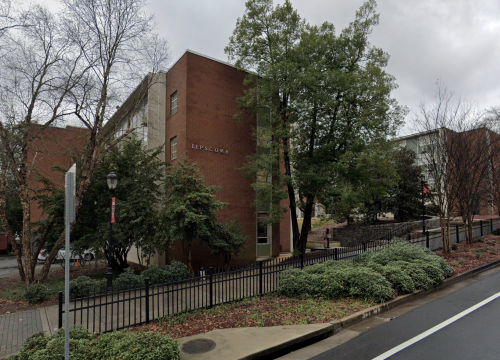Lipscomb Hall – UGA 2208; Mell Hall – UGA 2209; Hill Hall – UGA 2214; Church Hall – UGA 2215; Boggs Hall – UGA 2216; Tucker Hall – UGA 1250 (1961, Category 2). Lipscomb Hall was built as a residence hall. It was named in honor of Andrew A. Lipscomb, the university’s seventh president. This building is modern in its architectural style. Mell Hall is named for Chancellor Patrick Hues Mell. Hill Hall was named for Walter B. Hill, chancellor of the university at the turn of the twentieth century. Church Hall was named for Alonzo Church, president of the university from 1829 to 1859. Boggs Hall was and named for William E. Boggs, president of the university from 1888 to 1899.
The low-rise dormitories are six identical buildings all completed in 1961 in the Mid-Century Modern style. The project was designed by the Atlanta architectural firm of Logan and Williams. Five of the dormitories were located on the fifty- one-acre parcel located at the intersection of Baxter and South Lumpkin Streets. One of the dormitories, Tucker Hall, was located on the east side of campus and designated for agricultural program students.
The low-rise dormitories are four-story buildings with a ground level base with an exterior of painted concrete and three upper floors. In plan, each of the dormitory buildings consisted of a central lobby and elevator core with bedroom wings extending to each side. The two wings were offset from each other, creating a pinwheel effect around the central core in plan, and with one wing longer than the other.
In form, the central core is expressed as a simple rectangular brick mass, suspended in air above the ground floor entrance, which was set back and all glass. The brick mass is minimally punctuated by a few square window openings. Rectangular brick masses are also located at the end of each of the two wings, housing stair towers providing egress from the central corridors.
On the exterior, the two wings are expressed as metal curtain walls set within a thin concrete frame¾top, bottom and sides. Like the central core, the wings are raised above the building’s ground floor level, and their form emphasizes their horizontality. The metal curtain walls are composed of dark green metal panels with aluminum framing. Aluminum windows are ganged vertically within the framing, but the ganged windows create a horizontally rhythmic pattern. The horizontality is reinforced by the shape of the window sash and their mullions. Exterior air conditioning units have been installed on the metal panels of several of the buildings.
The interiors of the buildings have been modified with new finishes and doors but retain their overall simplicity. Tucker Hall has been adapted to academic and office use. The low-rise dormitories have a high degree of historic integrity and appear to contribute to a National Register-eligible historic district. They are assessed as Category 2 resources.

